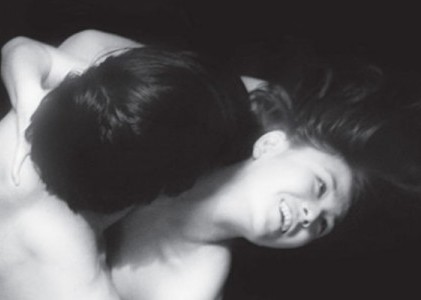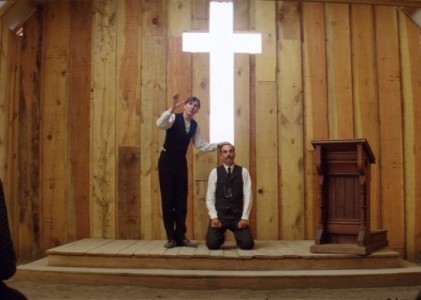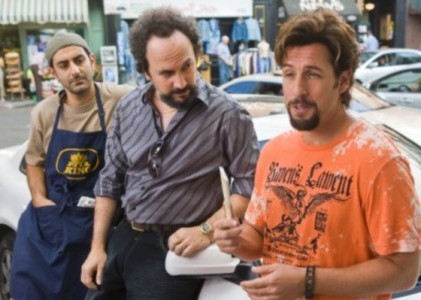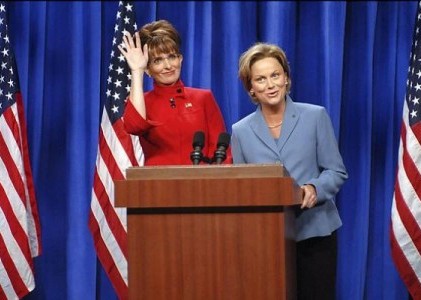Moments of 2008, Part 1
Moving Image Source launched in June 2008. To commemorate the end of our first year, we invited contributors and colleagues, as well as some of our favorite writers and artists, to select their moving-image moment or event of 2008—anything from an entire movie or TV series to an individual scene or shot, from a retrospective or exhibition to a viral video or video game.
Part 1 of the survey follows. Part 2—including responses from Todd Gitlin, Molly Haskell, Jonathan Lethem, and others—can be found here.
Guy Maddin, director of My Winnipeg
I love the 1989 public-access TV phenomenon Harvey Sid Fisher and his, as YouTube now lists it, "All 12 Astrology Songs Samples," in which the tuxed and dogged Fisher, aided by ghostly go-go dancers, drags all 12 signs of the zodiac across the finish line in just under 10 bouncy and melodious minutes.
David Carr, reporter and columnist, The New York Times; author of The Night of the Gun
When Gmail came up with their version of vidchat that works across all manner of platforms, I sent a note about getting the software—a 20-second process—to my twin daughters, away at college, and pinged one of them later that day. Erin, at the University of Wisconsin, popped up in the video chat window immediately, allowing me to inspect both the stud in her eyebrow and her growing facility with an acoustic guitar. To a father lonely for his child, there could be no more compelling content. She's a Mac, I'm a PC, she's somewhere else, I am here, and yet, we are together in an easy, friction-free universe where the future shows up in small but profound ways. The imperative to connect is as old as the Flintstones, but the moment was pure Jetsons.
Annette Insdorf, Director of Undergraduate Film Studies, Columbia University; author of Indelible Shadows: Film and the Holocaust
Attending the first screening of Slumdog Millionaire, which took place at the Telluride Film Festival. It wasn't just the exhilarating quality of the film itself, but the rush of discovery. I was among a few hundred cinephiles cheering, and then leaving the theater with a mission: we had to tell everyone that Slumdog Millionaire was not to be missed.
Joshua Clover, columnist, Film Quarterly; author of The Matrix
Just as The Wire offered incontrovertible evidence that conventional cinema had been for the moment outgrown as a narrative form (don't movies now seem, for better or worse, unbelievably short?), Grand Theft Auto IV has provided proof of concept for the video game's upping of the stakes of televisual engagement entirely. The recent ascent of the biopic probably testifies to the contraction of cinema's options in the face of this onslaught. I am all in favor of this contraction continuing, and would be happy if it continued down to four minutes. I now go to movies exclusively because music videos with high production values have all but disappeared, except as set pieces in films. My favorite this year was the chase scene early in Slumdog Millionaire, with kids ricocheting through Mumbai alleys, charged with glee and terror, to the strains of "O. Saya" (A R Rahman & M.I.A.). I wouldn't trade that kinetic thrill for a dozen Milks. Anything But Sentimental Realism—that's my platform for 2009.
Mark Harris, columnist, Entertainment Weekly; author of Pictures at a Revolution: Five Movies and the Birth of the New Hollywood
My choice is the YouTube video in which Sarah Palin's interview with Katie Couric was split-screened with Tina Fey and Amy Poehler's parody of it. I think this video is very emblematic of 2008: it's one part actual news footage, one part scripted entertainment, and one part homegrown user-generated content which combines those two elements into something much more revealing (and funny, and shocking, and meaningful) than either half of the footage would be on its own. I saw several movies this year—Milk, The Dark Knight, and Wendy and Lucy among them—that I found exciting both politically and artistically, but this video—fast, funny, rough-hewn, lethal—seemed completely organic to the moment in form, tone, and content.
Karina Longworth, editor, SpoutBlog
I'm sure everyone has their favorite Tina Fey-as-Sarah Palin moment—mine is the finger-gun salute during the Katie Couric interview spoof, complete with "pew pew" sound effects—but no moving image created in 2008 had a wider cultural reverberation than our first glimpse of the 30 Rock writer-star as the Alaska governor, presenting a "nonpartisan message...to address the ugly role sexism is playing in the campaign" alongside Amy Poehler's Hillary Clinton for the cold open of Saturday Night Live's season premiere. It was here where the bedrock of the impression was laid, from the spot-on wink to "I can see Russia from my house!" After five minutes of back-and-forth between Fey's "folksy," hyperfeminine airhead and the smilingly seething Poehler, our secret suspicions were confirmed: the presidential race had been fundamentally altered by a walking bimbo joke.
Troy Patterson, television critic, Slate
On the morning of August 29, word came that John McCain had selected the obscure leader of a remote state as his running mate. Who? Huh? How could any citizen with a healthy interest in showbiz resist turning to the Fox News Channel? In the hours between the rumor's confirmation and the candidate's campaign-trail debut, Fox presented file footage of a Sarah Palin photo op. Visiting soldiers at a shooting range, the governor wore a conspicuously snug T-shirt, a blue-ribbon smile, and an automatic weapon that the viewer saw her fire dozens and dozens of times as Fox, needing to fill time and knowing this clip was golden, repeated it with punishing insistence. This fusillade was the only proper introduction to a very modern demagogue, a media figure in whom the Gipper meets the goddess of the hunt.
David Schwartz, Chief Curator, Museum of the Moving Image
A blockbuster production complete with massive marketing, an appealing star who was the physical embodiment of a simple slogan ("change"), and a happy ending, the Obama campaign was the moving-image event of 2008. The use of video by and for the candidate was amazing in scope, originality, and impact. This includes commercials and video produced by the campaign, which spent a staggering $236 million on TV ads, as well as grassroots video made by amateurs. (A search of "Barack Obama" on YouTube yields about 150,000 videos.) The Obama campaign released highly targeted ads, going after Hispanic voters in Florida, environmentalists in Colorado, and mill workers in North Carolina. The barrage of positive and negative ads (and ads attacking McCain's attack ads) was relentless and laser-sharp, the advertising equivalent of the Powell Doctrine. There was a video for every occasion; even the Halloween video "Yes We Carve," a montage of pumpkins transformed into Obama logos and faces. The use of video was at times innovative (TV ads released with accompanying websites) and at times old-fashioned (half-hour speeches posted on YouTube were seen by millions). To see these and more, check LRC News at The Living Room Candidate. A personal favorite is this minute-long documentary about an immigrant who converted his gas station into a pro-Obama fundraising headquarters.
Tom Charity, film critic, CNN.com
Obviously the most moving moving-image moment—and the most memorable—has to be Obama's victory speech on election night. If that's taken as read, then I want to choose a moment from a movie that (as far as I know) hasn't figured in anyone's Oscar prognostications or 10-best lists. Lakeview Terrace ultimately can't transcend a premise that belongs to the yuppie paranoia cycle of the early 1990s, but at least in the first half it generates several moments of naked social, racially aggrieved tension with a bluntness worthy of Sam Fuller. There is one sequence that stands out: a scene in which Patrick Wilson drives into the suburban cul-de-sac that is his new home. Instead of parking in his garage he pulls over a few doors down, cuts the engine, and lights himself a cigarette. Director Neil LaBute lets this seemingly trivial action play out with a patience that has become all too rare in Hollywood movies. He allows Wilson to relish his vice—a habit his wife (Kerry Washington) evidently disapproves of—and gives us time to wonder what this says about their marriage. Only then does he move on to the real business of the scene, the startling introduction of Wilson's neighbor (Sam Jackson) rapping on his window as if to rob him. In fact he's not a threat, but a cop, moonlighting as neighborhood watch. The scene—which derives another layer of irony from the rap Wilson is listening to on his iPod—sums up the movie's bracingly sceptical take on America's supposedly post-racial harmony. Whether Obama's victory gives the lie to that cynicism I don't think we know yet. But for all its excess, Lakeview Terrace seems to me a more honest provocation than Paul Haggis's Oscar-winning Crash.
Jonathan Rosenbaum, critic and author of Discovering Orson Welles
For me, 2008 was marked by the returns of two filmmaker giants: Terence Davies (Of Time and the City) and Pere Portabella (The Silence Before Bach). In fact, their films premiered in successive years—the Portabella, his first feature since Warsaw Bridge (1990), surfaced in 2007 in Venice, and the Davies, his first feature since The House of Mirth (2000), surfaced in Cannes in 2008—but the means by which we nowadays establish the dates of films is generally so irrelevant to our experiences of them that I hope I can be given some license in this matter. In any case, 2009 will be the year when Portabella's work will finally become available on DVD (in Spain, with English subtitles), and 2008 was the year in which Davies's Distant Voices, Still Lives and The Long Day Closes finally came out on DVD in the U.K.

Christoph Huber, film critic, Die Presse
The sighting of two masters at this year's Venice film festival: Giulio Questi, looking as angry as ever (especially when smiled at) as he stood mostly unrecognized in the crowd before the presentation of his maudit masterpiece Arcana. The last and most mysterious of his three big-screen features, it confirmed him as one of the most original and uncompromising directors of all time (shouldn't he be at least as famous as Vigo?). And star comedian (and filmmaker) Adriana Celentano, cheered by adoring fans, as he relaxedly walked the red carpet to present the restoration of his incredible anarchist-populist musical comedy Yuppi Du. Two very different people and experiences, but their two relentlessly innovative films cry out to be rediscovered as key works of their eras (and grand political entertainments). Together they gave the impression that there was no greater freedom possible than in Italian cinema in the first half of the 1970s.
Jean-Michel Frodon, editor in chief, Cahiers du Cinéma
I am a happy film critic—indeed! I do enjoy so many encounters with films all along the year. Nevertheless the most unforgettable moment for me in 2008 was not the discovery of a new film. Though so many were great, my most significant and to-be remembered experience as a filmgoer was a re-encounter with a film I saw 30 years ago, but then hardly understood, and certainly did not acknowledge as the masterpiece it is. This film is Kiju Yoshida's Eros+Massacre—in its correct, never seen before, full length. This 1969 film seems to me as innovative, as beautiful, and as sincere as the very few major landmarks in the history of cinema. I am aware my own answer is not that creative, and maybe not beautiful, but it is definitely sincere. 
David Cairns, critic and filmmaker
I attended a rare screening of Sidney Lumet's Tennessee Williams adaptation Blood Kin and was most impressed by a shot where a giant plastic cow was wheeled past James Coburn. It made me feel alive in a special way. The combination of elements—Coburn and cow—something about it was just so right, and so bold. On the other hand, I can't be absolutely sure I didn't dream the whole thing, so I'm going to nominate Daniel Day-Lewis's baptism scene in There Will Be Blood, which is the point where D-Day starts to become grotesquely comical, a trend continued in the second half of the film. Some find this descent into ham regrettable—I don't, but even if I didn't like the results, I would be impressed by the courage.

Christopher Wisniewski, director of education, Museum of the Moving Image; staff writer, Reverse Shot
Eight minutes, one shot. At the climax of Hou Hsiao-hsien's Flight of the Red Balloon, a blind tuner comes to an apartment to work on a piano. A boy plays video games on the other side of the room, when his sister calls from Belgium. His mother (Juliette Binoche, delivering the performance of the year) crashes in, arguing with a neighbor. She takes the phone, and quietly begs her daughter to come back to Paris, without success. Finally, she talks to her son about school, embraces him, and smiles radiantly as she walks away. Hou's restless camera stays mostly in a fixed position, surveying the cluttered Parisian apartment with pans and tilts, amidst a cacophony of notes and blips, ringing phones and hushed conversations. The simple family drama that unfolds in this exhilarating, breathtaking shot is tender, lovely, and desperately sad.
David Hudson, editor, GreenCine Daily (and, as of January 1, blogger, The Daily at IFC.com)
Oddly enough, the year that fizzled out in financial meltdown, leading to wide-open talk in the mainstream media about the severely dimmed future of capitalism as well as a revival of interest in Karl Marx, had actually been punctuated all along with flirtatious glimpses at past insurgencies: Koji Wakamatsu's United Red Army made its international debut in Berlin; Steven Soderbergh's Che in Cannes, in a month that saw the 40th anniversary of May 1968 marked just about all over, onscreen and off; and Bernd Eichinger hoped to score awards and euros when he opened Der Baader Meinhof Komplex all across Germany in the fall. But for me, it was United Red Army that offered both one of the most horrible images and funniest concepts of 2008, both of them fair warnings of the dangers of diving off the deep end on the other side: a beautiful woman pounding her own face to a bloody formless mass as an act of "self-criticism"; and the "counter-revolutionary cookie."
Mark Peranson, editor, Cinema Scope; director of Waiting for Sancho
Recent events moved me to rewatch a film that received very little love on year-end Top 10 lists (including mine, as I didn’t make one). Since being freed from his generic template of "id unleashed" by exercising his dramatic chops in a minor Paul Thomas Anderson film, Adam Sandler has become downright daring in his character choices, especially when the roles are seen as riffs on Jewish identity (even Chuck’s last name was Levine). But nobody can mess with the Zohan, part steamy Sabra swagger, part Scrappy Coco. The old homilies about getting gangs from the opposite sides of the street to sit down and laugh together to make peace applies, but the one scene that goes above and beyond the Israeli-Palestinian troubles—and a dead-on memento mori of what Sandler, clearly having fun, must have experienced when he visited the Holy Land in the mid '80s—is one that I had forgotten but indeed resonates with recent events. In a hazy flashback, Sandler’s frequent co-conspirator Rob Schneider (here, naturally, playing an Arab cab driver) remembers his encounter with the Zohan in an anonymous Palestinian village. Offended by the interlocutor’s presence, Schneider reacts with a now too-familiar traditional Arab insult: by throwing his shoe. In return, Zohan steals his pet goat.

Thomas Doherty, professor of American Studies at Brandeis University; author of Hollywood's Censor: Joseph I. Breen and the Production Code Administration
For me, the most memorable motion picture imagery of 2008 is locked in a dead heat, a yin-yang face-off between dark and light: 1) the spectral shot of the late Heath Ledger as the Joker in The Dark Knight, leaning out of a car window, lapping up the night air, in full-on demented glee. I've been annoying my wife all year with what I think is a not-bad imitation of his tagline query: "Why so serious?" 2) not to go all mushy and one-world on you, but the viral video Where the Hell Is Matt? never ceases to move and astound me. In a bewildering array of real, not digital, planetary backdrops, a good-natured dude named Matt performs a silly little jig—solo against the scenery, with local citizens in exotic dress, amid clumps of ecstatic children. It's a contagious celebration of the unity of all humankind and a tribute to the marketing genius of Stride gum. ![]()
LATEST ARTICLES
-20140814-173707-thumb3.jpg)
Fighting Words
by Imogen Sara Smith
posted August 12, 2014

Fighting Words, Part 2
by Imogen Sara Smith
posted August 20, 2014

On the Margins: The Fil…
by Andrew Chan
posted August 12, 2014

Robin Williams: A Sense…
by David Schwartz
posted August 12, 2014
 Moments of 2008, Part 1
Moments of 2008, Part 1
RELATED ARTICLE
Moments of 2008, Part 2 by Various WritersMoments of 2011, Part 2 by Various Writers
Moments of 2011, Part 1 by Various Writers
Moments of 2012, Part 1 by Various Writers
More: Article Archive

